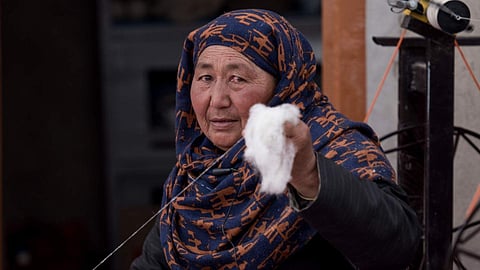

Ladakh, the youngest union territory of India, is one of the largest producers of the luxurious pashmina. Even though the world associates Kashmir with the fabric, Ladakh is no less when it comes to exporting its raw ingredients. Even though this Himalayan region has a rich history of woven pashmina clothing, it's losing out when it comes to value addition.
IAS officer G Prasanna Ramaswamy, when on one of his district tours to a border village in the Changthang region — Chumur — was greeted with beautiful knitwear as a gift. "It struck me that people living in these remote areas too have some amazing craftsmanship but are not being able to capitalise on that," said Prasanna.
He gradually realised that there is a massive gap when it comes to the products that leave Ladakh and the final products that get sold in the market. So, he and his wife Abhilasha Bahuguna wanted to bridge this financial gap and also bring the art and craft of the Ladakhis to the forefront — and thus, Looms of Ladakh Women’s Cooperative was born - to ensure their products are sold online and they reap the benefits directly.
Power to you
The cooperative is run solely by the women of Ladakh and for most of them, this was a big step. The centres are situated in their villages and they are in constant touch with Abhilasha, in Kashmir, over video calls. Lobzang Lamo, who is the CEO of Looms of Ladakh was a homemaker before she joined the initiative. "The cooperative gave us exposure and we learnt not just the craft but every aspect of the trade. When the COVID-19 pandemic hit, we hit a rough patch. But we soon moved online. We started selling our products more on Instagram and will soon have a website," said Lobzang, who is now tech-savvy and even helps Abhilasha with the posts.
Reviving a craft is not just about giving the artisans a platform but also helps them grow and keep updating themselves. Here, the women are the designers and they have been taking inspiration from their everyday lives. "We look at what people are wearing across the big cities — the internet helps. We also observe the tourists who visit us. We have been developing our designs accordingly," said Lobzang, who is also an elected design officer. The cooperative runs like a democracy. There are elections where people file nominations and then there are polls that help elect women to all posts.
Part of the chain
But how did the herders and weavers get left out of the value addition chain? Prasanna explains, "A decade back, a study found that the total value of pashmina after going through the value addition chain is more than Rs 200 crores while the pashmina in its raw form was sold to the market for about Rs 12 crore. The stark difference is evident. Our objective was to retain a part of the value addition to be with the primary producers in Ladakh. We also hoped to incentivise the semi-nomadic tribes to continue with their traditional way of life. With the advent of tourism, people are moving away from their traditional craft. Most of the women who are now part of Looms of Ladakh were also engaged in unskilled labour or were homemakers. We have trained more than 150 women in the art of weaving and knitting pashmina, yak wool, sheep wool etc." The IAS officer who started the cooperative when he was Deputy Commissioner (DC) of Leh in 2016.
While the emphasis is on Pashmina in Ladakh, the cooperative did not just concentrate on that, said Abhilasha. "The cooperative understood that it needs to balance all the local wools and pashmina can be just a niche product. The emphasis here is on the craft. People who were involved in these traditional crafts are shifting careers. All the skill development programmes are conducted in villages around Leh and not in the interiors," she added.
Know where you are going
The women or the founders did not want outsiders joining the cooperative in its formative years, but now, after four years, the cooperative is set to employ its first few employees. The women are confident with what they do and what they have planned. While they would appreciate some help from professionals, they would have the last word. "We are now confident. We know what we are doing. Whether its design or finances — we have been handling all of it with help from Abhilasha. So we will obviously have a say on these," said Shakeela Bano, cashier of the cooperative.
The women who were either homemakers or were engaged in unskilled labour have found a way to not just learn a craft but have a successful professional life. And they have had support from their family. "My loved ones were very happy. We have been working here for more than four years now and it's a satisfying experience," said Sonam Palkit, from Kharnakling, who is a member.
